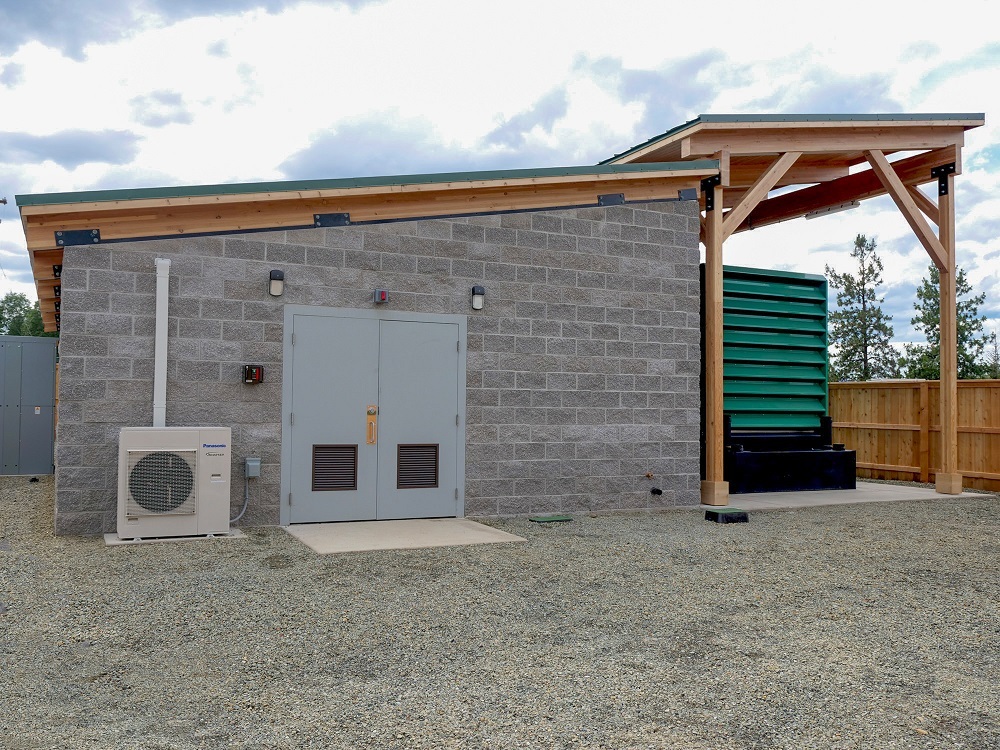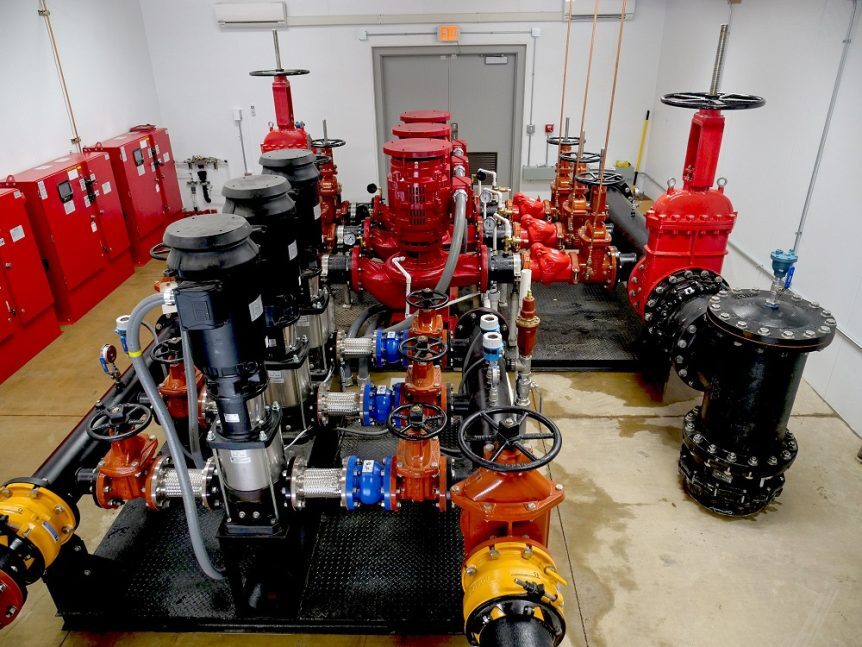Booster pumping stations are a unique system with a specific purpose to pump water to a specific location that come with various considerations when designing and installing.
Booster pump systems push or “boost the flow of clean water”. Typically, these are installed for new developments, both residential and commercial.
These Booster pumping skids are normally above grade and housed in a building. At Romtec Utilities, we completely prefabricate and pressure test the skid before it arrives at the job site, so it just needs to be dropped into place.
The booster skid will either need to be delivered before the building is completed or the building must be designed for the skid to be removed and replaced through a roll-up door. Romtec Utilities recommends designing the building so that the skid or any of its components can be installed and removed at any time for maintenance reasons.
When it comes to commissioning, special considerations are taken in account for booster stations relative to water discharge, additional time relative to programming, and even additional personnel based on the application of the system.

Prefabrication
Romtec Utilities’ high-level prefabrication process is complete prior to the delivery of the system to the jobsite. Having a booster skid totally prefabricated prior to delivery greatly reduces construction cost and installation time, as well as potential project delays and change orders. The prefabrication process can often reduce installation time from weeks to days.
Additionally, Romtec Utilities takes pride in our quality control processes, ensuring that when the system is delivered to the job site everything will function as designed.
After the system is tested and goes through our final quality control process, we prepare the booster skid for delivery to the job site in accordance with the installation process.

Installation of the Booster Skid
The installation of the booster skid will be in conjunction with the construction of the building that it is housed in. At Romtec Utilities we also do the design, supply, and construction of the building that is part of the booster skid installation process.
Designing the building to accommodate the booster skid installation along with the rest of the construction of the building is crucial.
We have a team of designers and architects who help with the overall design of the building in cohesion with the booster pump system.
Commissioning the Booster Skid Entails Many Considerations
Does the application include supporting Fire Flow?
“Fire Flow” means that the system is supporting the suppression of fire through either hydrants or sprinklers. If a system supports “Fire Flow” then it is likely a requirement that the local Fire Marshal’s presence is required at Romtec Utilities’ commissioning to inspect the system and its performance. This process verifies items like proper flow and pressure at the desired discharge location.
NFPA (National Fire Protection Association) 20 rated equipment can require further testing.
Per the NFPA 20 requirements specific tests such as independent flow/pressure testing for each pump is required. Essentially the responsible party for testing needs to build a “Pump Curve” for each pump. This is again, done by testing different flow rates at multiple pressure setpoints.
NFPA 20 rated pumps are supposed to operate independently. This means that each pump has its own control panel and will operate separately of the others.
Additional testing requirements will obviously require more time and effort on-site.

Booster Station Operation requires intensive PLC programming and Control
A booster station will commonly pump based on demand, as opposed to a fixed rate. In order to accommodate an ever-changing flow rate, the system is controlled via a “Closed Loop” control scheme. This means that we are obtaining input from field devices (typically pressure transmitters) that report the pressure at the discharge of the system.
Closed loop control incorporates PID control to maintain pressure at the discharge of the system. Essentially, as pressure drops, pumps will turn on as well as increase their speed, to maintain pressure.
This control scheme needs to be fine-tuned in the field once it is connected to the suction and pressure lines. This process can be time intensive as we are adjusting the pump station to its new environmental factors.

Testing the Duty Point is not as Straight Forward
Whenever Romtec Utilities commissions a pump station we perform a “flow” test for each pump in the system to ensure that it is pumping at the desired “duty” point when connected to the force main.
A duty point is the flow (in GPM) @ a certain TDH (Total Dynamic Head).
With a lift station, all that is needed is to ensure that the discharge location is clear, and we are allowed to discharge. However, for a booster station, the point of discharge is often a sink, toilet, shower, fire hydrant, sprinklers, etc. So, if the flow at the point of discharge is needed, someone would physically have to open the corresponding discharge location.
Typically, if it is not feasible to open all the discharge locations Romtec Utilities will use the “Dead Head” discharge pressure measured at the booster station discharge to verify that the pump is on the desired pump curve.
Aside from ensuring each pump hits the desired duty point, having water consumption at the point of discharge also provides an opportunity for the system’s “closed loop controls” to respond. At this point additional tuning of the PID loop may be needed.
Completed Romtec Utilities Projects
We recently provided a booster skid pump station and control building for Rogue Community College (RCC). RCC wanted to move from their well water systems to municipal-supplied water. The booster station helped with this transition as it now supplies water to the entire campus and the new science building which is 17,200 square feet.
The booster system is also supplying fire flow for the campus hydrants and sprinklers. As demand for water increases on the campus, the (3) smaller domestic pumps will sequentially turn on until they are unable to keep up with demand. At this point the NFPA rated fire pumps from Anvil Fire will turn on. Again, the (3) fire pumps will also turn on sequentially to keep up with demand.
The City of Hesperia booster station project entailed pumping recycled water from the Victor Valley Reclamation Facility, which discharges reclaimed water into tanks adjacent to the booster station. The booster station receives water from these tanks and pumps the water to multiple park sprinkler systems before ultimately discharging into a golf course pond. The booster station helps recycle up to one million gallons of wastewater a day.
Booster skid pumping stations require more field adjustments as their control scheme is based on input from environmental demand. This can be time consuming to replicate and obtain but Romtec Utilities provides assistance during the commissioning process to ensure a successful operation of the system.
From the design, prefabrication, delivery, and commissioning of the booster skid pump station, Romtec Utilities provides a complete scope of work to ensure your project is a success.


